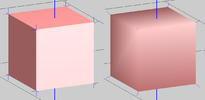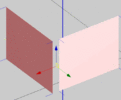- Joined
- Jun 2, 2008
- Messages
- 541
Here's a one geoset cube, six unconnected square sides made out of two connected triangles. On the left is how it should look, on the right is how it looks after saving in mdlvis

I think what happens is that mdlvis averages the normals of vertices that occupy the same coordinates within one geoset. I always thought to myself "why do standard blizz models have their geometry all in weird unconnected patches when there's no difference?" Well turns out there's a difference but I couldn't see it because mdlvis screws it up.
If you don't think this is bad or this doesn't concern you, then look at Jaina's face after saving in mdlvis
Here's a post by @Hermit with one solution and there's a few more up in the same thread. One other (mdlvis only) workaround is detaching some of geometry into a different geoset (like that same cube above on the left, which is actually six geosets and not one).
I realize that I'm not discovering anything new here, but I could never find how exactly mdlvis screws the normals. Well, now I think I know how.
If you're just starting modelling then do yourself a favor and learn RMS or something else. We're too far gone but it's not too late for you!

I think what happens is that mdlvis averages the normals of vertices that occupy the same coordinates within one geoset. I always thought to myself "why do standard blizz models have their geometry all in weird unconnected patches when there's no difference?" Well turns out there's a difference but I couldn't see it because mdlvis screws it up.
If you don't think this is bad or this doesn't concern you, then look at Jaina's face after saving in mdlvis
Here's a post by @Hermit with one solution and there's a few more up in the same thread. One other (mdlvis only) workaround is detaching some of geometry into a different geoset (like that same cube above on the left, which is actually six geosets and not one).
I realize that I'm not discovering anything new here, but I could never find how exactly mdlvis screws the normals. Well, now I think I know how.
If you're just starting modelling then do yourself a favor and learn RMS or something else. We're too far gone but it's not too late for you!



